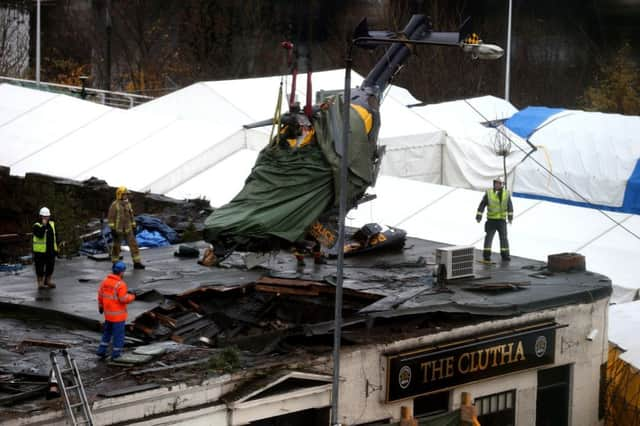Fuel theory ruled out, Clutha inquiry hears
This article contains affiliate links. We may earn a small commission on items purchased through this article, but that does not affect our editorial judgement.


Holger Mendick, a compliance verification engineer with Airbus, the helicopter’s manufacturer, also discounted the theory that an accumulation of water droplets between the concentric tubes of the sensor could have caused it to short circuit, because there was no “fuel quantity fail” caption warning triggered in the cockpit.
Under questioning from Procurator Fiscal Depute Sean Smith, the fuel systems expert agreed that in “principle,” a build-up of water droplets over time at the bottom of the sensors might have interfered with the readings.
Advertisement
Hide AdAdvertisement
Hide AdHe said he would have expected any such overreading to have occurred prior to the Police Scotland helicopter’s final flight in November 2013, which left 10 people dead after the aircraft crashed into the Cluths Bar in Glasgow.
On the eighth day of a Fatal Accident Inquiry into the incident, the court earlier heard how Airbus prepared a presentation just two months after the crash which concluded that the aircraft’s fuel tanks could be contaminated with water during routine engine compressor washes.
In the presentation, prepared in January 2014, Airbus specialists said water was able to be “sucked back” into the helicopter’s internal fuel system.
Mr Mendick said the “specific phenomenon” had been known about several years previously, and was under investigation by the engine manufacturer.
The 44-year-old said although a “service bulletin” was issued in 2003, with a subsequent revision in 2005, it did not “completely eliminate the problem.”
Mr Mendick also told the court that free water which accumulates at the bottom of the sump of the fuel tank was not a problem.
However, he said that “what has to be avoided is a mixture of fuel and water, especially this premixture coming down from the engine or somewhere else.”
The inquiry also heard about a series of fuel system tests Airbus carried out on a test rig of the EC135 model helicopter, which saw water injected directly into the aircraft’s pump inlet to see how it reacted, and whether it was pumped into the fuel tanks.
Advertisement
Hide AdAdvertisement
Hide AdHowever, the water accumulated at the bottom of the tanks, both when the transfer pumps were switched on, and when they were off, according to the results of the test, carried out in April 2015.
The test was “accelerated” using a high amount of water, some 480ml, injected into the main tank transfer pump using a syringe in 60ml amounts, half an hour apart, which created a cloud of water and fuel emulsion.
Asked by Mr Smith about the results, Mr Mendick said: “We see emulsion being created in the supply tank and this emulsion also starts to flow back into the main tank.”
The water contamination test conclusions found that as the water accumulated at the bottom of the tank, not all the free water could be sucked in by the pumps, leaving free water in the main tank.
It added that the emulsion, if generated, “will always end up in the supply tanks and the main tank after a certain time” - approximately 400 kilograms of fuel backflow into the main tank over the course of 30 minutes - which leaves traces of free water “all over the system.”
The report added: “The drift generated by emulsified water does not disappear after the fuel clears.”
Mr Mendick, who compared the process to vinegar mixing with oil, explained: “As soon as the fuel was gone, this drift should get clear, but it wasn’t, which was an indication to us that this water was remaining.”
The test, he went on, found that the only way to generate a drift of both supply tank sensors during a flight was to create a significant amount of water/fuel emulsion which requires a lot of free water in the main tank.
Advertisement
Hide AdAdvertisement
Hide AdSome nine kilograms of drift was recorded with half a litre of water during three cycles on the rest rig, which left traces of “free water” in the main and supply tanks.”
The test conclusions added: “ The total absence of water in the G-SPAO tanks proves that the speculated intermittent overreading during the accident flight, which commenced with a correctly working fuel indication system, can be excluded.”
The inquiry continues.